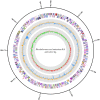Complete genome sequence of Rhodothermaceae bacterium RA with cellulolytic and xylanolytic activities
- PMID: 30105201
- PMCID: PMC6087703
- DOI: 10.1007/s13205-018-1391-z
Complete genome sequence of Rhodothermaceae bacterium RA with cellulolytic and xylanolytic activities
Abstract
Rhodothermaceae bacterium RA is a halo-thermophile isolated from a saline hot spring. Previously, the genome of this bacterium was sequenced using a HiSeq 2500 platform culminating in 91 contigs. In this report, we report on the resequencing of its complete genome using a PacBio RSII platform. The genome has a GC content of 68.3%, is 4,653,222 bp in size, and encodes 3711 genes. We are interested in understanding the carbohydrate metabolic pathway, in particular the lignocellulosic biomass degradation pathway. Strain RA harbors 57 glycosyl hydrolase (GH) genes that are affiliated with 30 families. The bacterium consists of cellulose-acting (GH 3, 5, 9, and 44) and hemicellulose-acting enzymes (GH 3, 10, and 43). A crude cell-free extract of the bacterium exhibited endoglucanase, xylanase, β-glucosidase, and β-xylosidase activities. The complete genome information coupled with biochemical assays confirms that strain RA is able to degrade cellulose and xylan. Therefore, strain RA is another excellent member of family Rhodothermaceae as a repository of novel and thermostable cellulolytic and hemicellulolytic enzymes.
Keywords: Cellulase; Halophile; Rhodothermaceae; Rhodothermus; Xylanase.
Conflict of interest statement
Compliance with ethical standardsThe authors declare that there is no conflict of interest regarding the publication of this article.
Figures


References
-
- Alfredsson GA, Kristjansson JK, Hjörleifsdottir S, Stetter KO. Rhodothermus marinus, gen. nov., sp. nov., a thermophilic, halophilic bacterium from submarine hot springs in Iceland. Microbiology. 1988;134:299–306. doi: 10.1099/00221287-134-2-299. - DOI
-
- Bleicher L, Prates ET, Gomes TC, Silveira RL, Nascimento AS, Rojas AL, Golubev A, Martínez L, Skaf MS, Polikarpov I. Molecular basis of the thermostability and thermophilicity of laminarinases: X-ray structure of the hyperthermostable laminarinase from Rhodothermus marinus and molecular dynamics simulations. J Phys Chem B. 2011;115:7940–7949. doi: 10.1021/jp200330z. - DOI - PubMed
LinkOut - more resources
Full Text Sources
Other Literature Sources
Molecular Biology Databases
Miscellaneous

